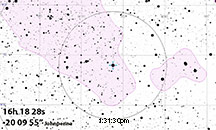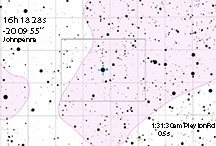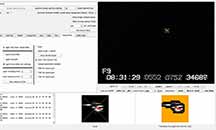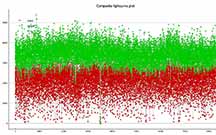

This is a very bright occultation in Scorpius, with a duration of 0.5 seconds and decent altitude for good 1x timing. The target star is very red. IR J-band magnitude 4.0. The path hits too far south along Hwy 1 in Big Sur to make it the favored location, given the road there. Instead, the location best is along Jolon Rd north of Lake San Antonio.
To get the best data, we will want to use 1x and also to reduce gain until the star isn't saturated. By reducing gain, you preserve S/N accuracy while just lowering the counts. This is FAR better than changing gamma, or cutting exposure, or making it far out of focus. Because by cutting exposure, you're hurting S/N with fewer actual photons arriving at their Poisson distributed arrival times. You want instead to count every photon, but scale down the number associated with the count rate. With 1x you can get highest time resolution, and also allow good S/N by cutting gain only.
I've requested a van for Thur May
The weather image looks promising, from ECMWF and Weather.us
click here to see the live cloud image for California
Alt=33, Az=182 due south, just 1 degree left of the top stars in the head of Scorpius.
 |
 |
A good success. Kirk, Bernard, and I all got usable records of this bright asteroid at high cadence.
I set up furthest south, on Interlake Rd. I took photos to document my exact position relative to trees on the GoogleEarth view, after recording my long/lat approximate from my iPhone compass app.
Long=121 03 57.80s
N. Lat=35 53 44.78"
elev 256m
My OccBox battery was too drained to power my gear, but before the event, Bernard's spare battery was lent to me. It was operating on only 26% charge, and this may have meant lower voltage but therefore higher current. Whatever the cause, I had much horizontal rows instability in both numerals and star image. This prevented OCR of the UT time stamps, which then had to be manually. Also, processing in PyMovie and PyOTE was very slow perhaps because positioning using time was not possible. I ended up cutting out just the seconds before, during, and after the event and using just that for my analysis video. I first verified there were no other drops in the PyMovie record which might be due to a moonlet.
The star took about 5 fields to fully disappear, and another ~5 fields to fully reappear, so that a Square Wave timing analysis, as confirmed by Bob Anderson, would NOT provide the correct timings. It must be done in PyOTE with the "disk on disk" model. I will first have to work through the exact right steps and numbers to put in in order to help my team then do it with their data.
 |
 |
 |
 |
 |
The gradual D and R means that this event needs to be done with the "disk on disk" method, not "square wave". That method was not polished in the software yet to be easy to use, and I will have to do some experimenting and then put together a process to share with others on how to do this.